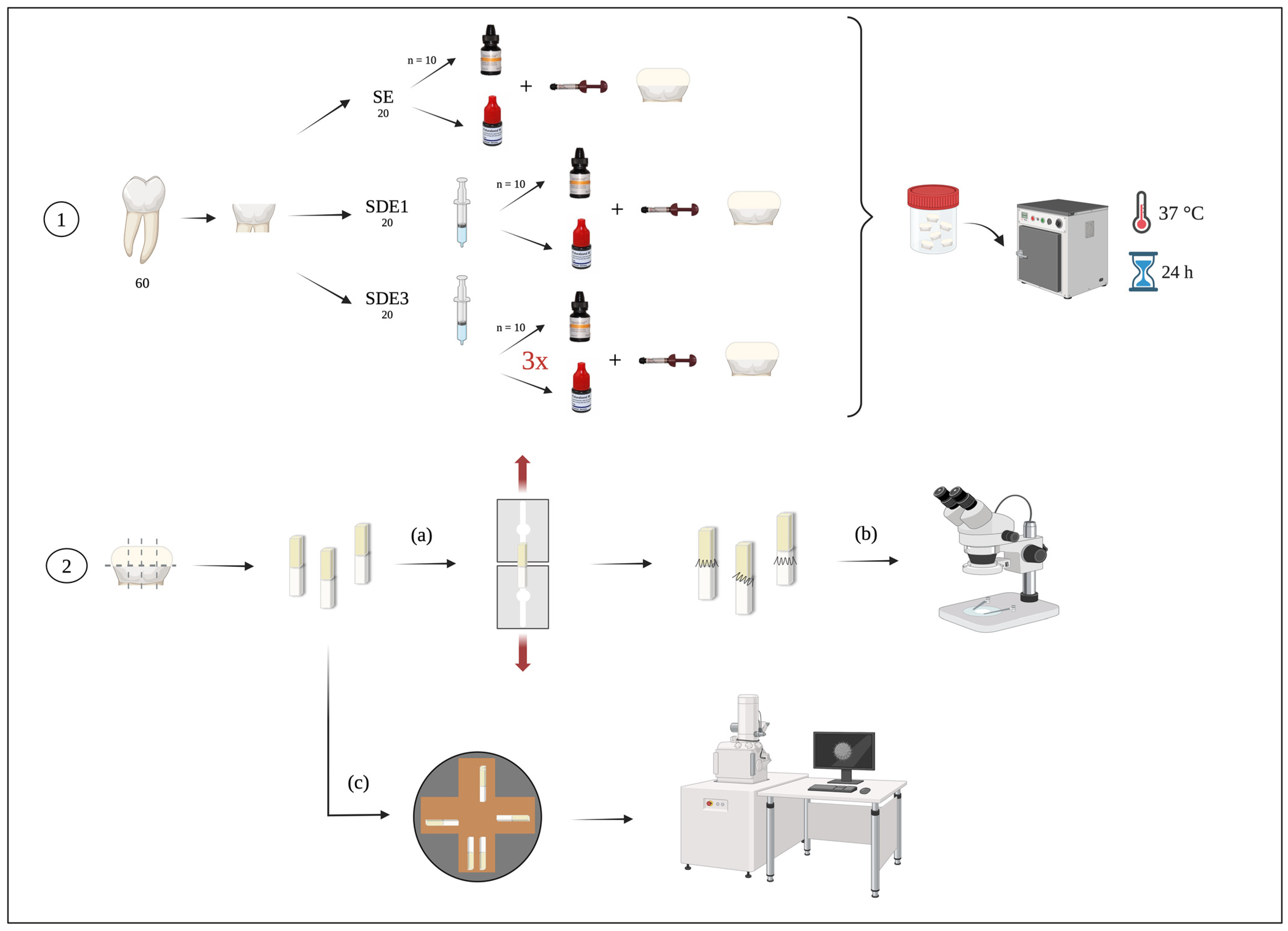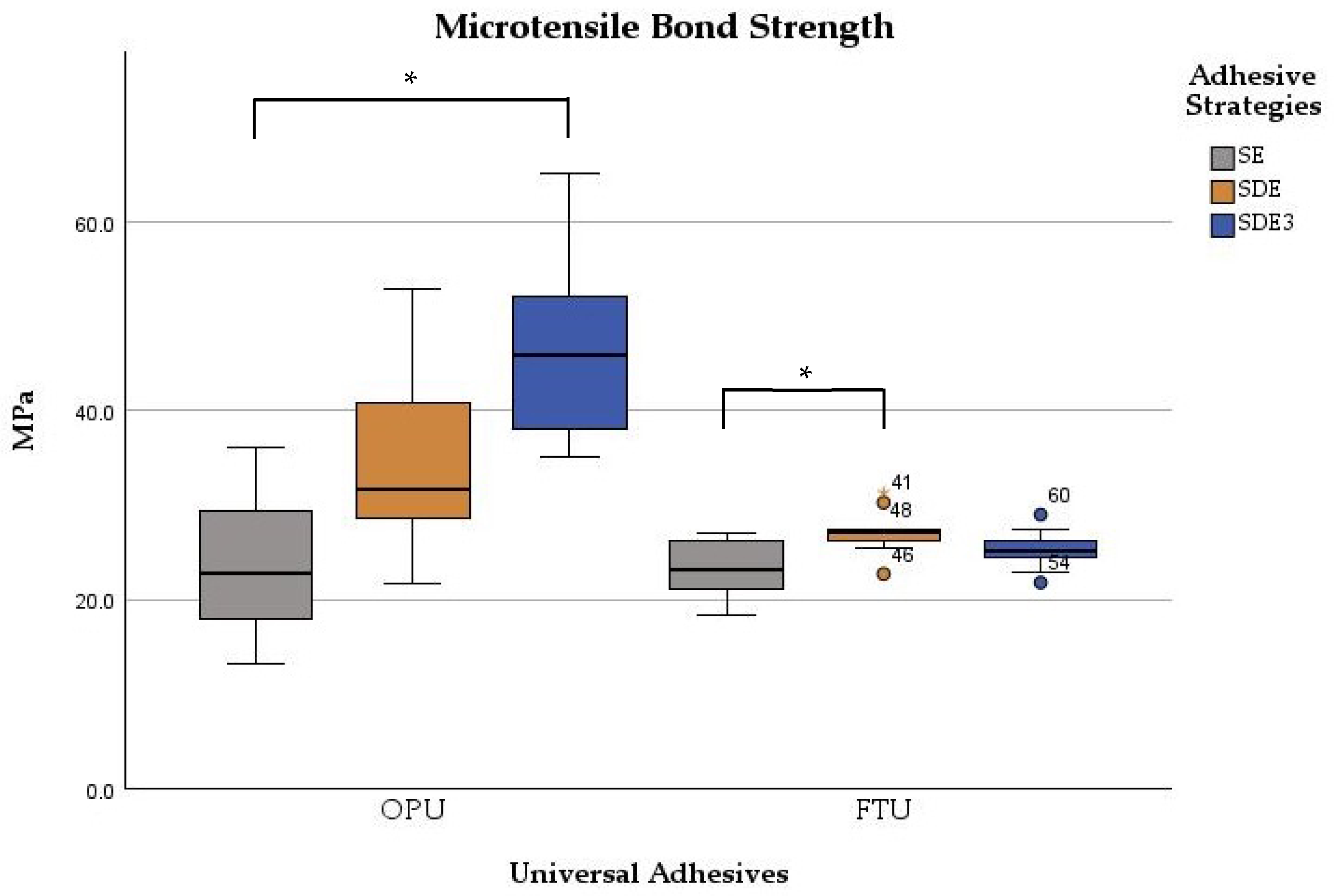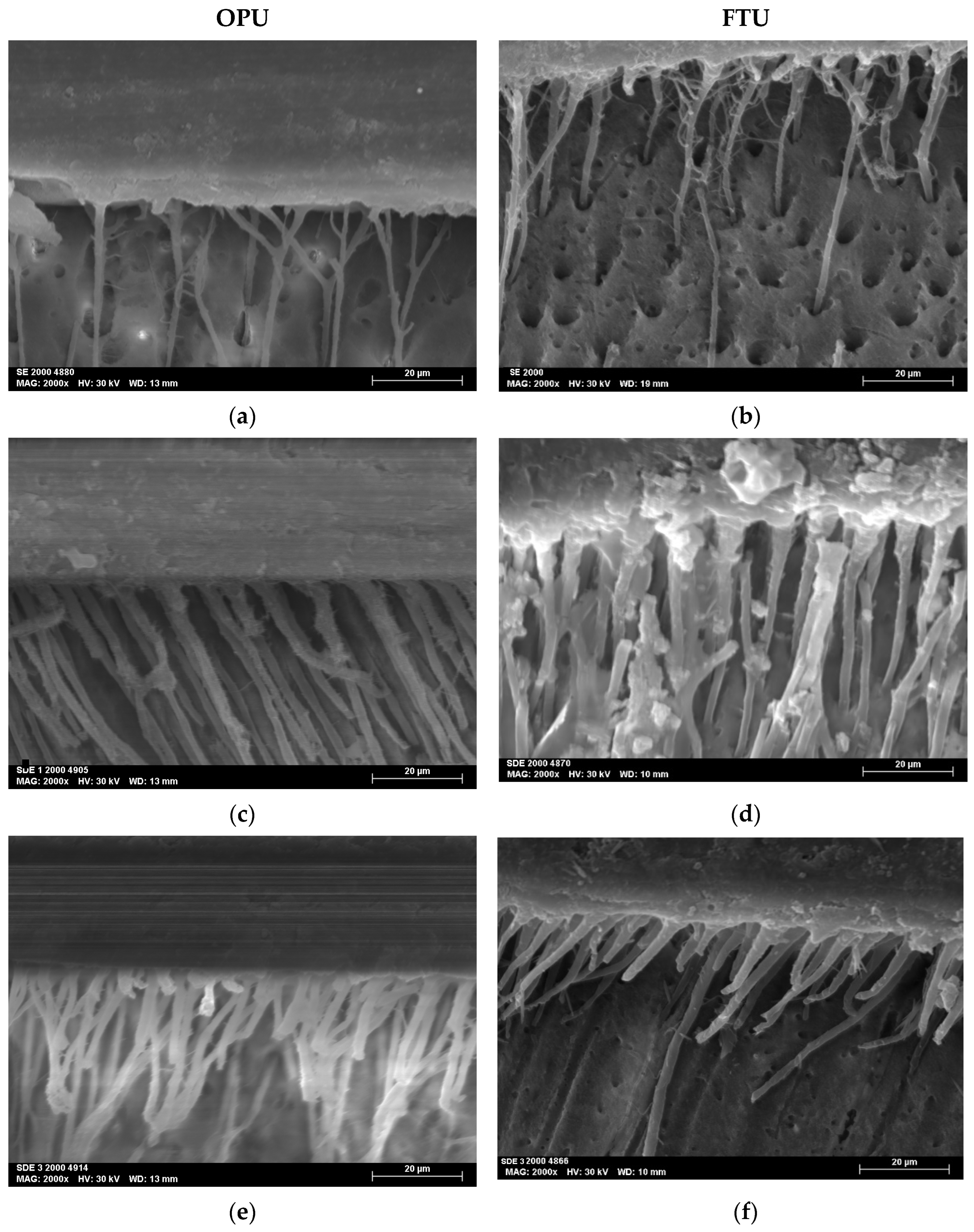Improving Bonding Protocols: The Effect of Selective Dentin Etching with Two Different Universal Adhesives—An In Vitro Study
Abstract
1. Introduction
2. Materials and Methods
2.1. Specimen’s Preparation
- SE (control group)—SE strategy;
- SDE (experimental group)—SDE strategy;
- SDE3 (experimental group)—SDE strategy with three consecutive adhesive layers.
2.2. Microtensile Bond Strength (μTBS)
2.3. Scanning Electronic Microscopy (SEM)
2.4. Statistical Analysis
3. Results
3.1. Microtensile Bond Strength (μTBS)
3.2. Failure Classification
3.3. Scanning Electronic Microscopy (SEM)
4. Discussion
5. Conclusions
- The bond strength to dentin at 24 h was significantly influenced by the bonding strategy for both adhesives tested;
- For OPU, the application of three layers of adhesive with SDE significantly enhanced dentin bond strength compared to the SE protocol;
- FTU showed improvement when employing the SDE strategy, without additional benefit from multilayer application;
- SDE protocols resulted in the formation of numerous, longer, and more robust resin tag extensions.
Author Contributions
Funding
Institutional Review Board Statement
Data Availability Statement
Acknowledgments
Conflicts of Interest
Abbreviations
| FTU | Futurabond M+ |
| OPU | OptibondTM Universal |
| SDE | selective dentin etching |
| SDE3 | selective dentin etching |
| SE | self-etch |
| SEM | scanning electronic microscopy |
| μTBS | microtensile bond strength |
| LED | light-emitting diode |
| SPSS | statistical package for the social sciences |
References
- Green, D.; Banerjee, A. Contemporary Adhesive Bonding: Bridging the Gap between Research and Clinical Practice. Dent. Update 2011, 38, 439–449. [Google Scholar] [CrossRef] [PubMed]
- Desai, H.; Stewart, C.; Finer, Y. Minimally Invasive Therapies for the Management of Dental Caries—A Literature Review. Dent. J. 2021, 9, 147. [Google Scholar] [CrossRef]
- Elkaffas, A.A.; Hamama, H.H.H.; Mahmoud, S.H. Do Universal Adhesives Promote Bonding to Dentin? A Systematic Review and Meta-Analysis. Restor. Dent. Endod. 2018, 43, e29. [Google Scholar] [CrossRef] [PubMed]
- Shen, C.; Rawls, H.R.; Esquivel-Upshaw, J.F. Phillips’ Science of Dental Materials, 13th ed.; Elsevier: St Louis, MO, USA, 2021; pp. 115–127. [Google Scholar]
- Stape, T.H.S.; Wik, P.; Mutluay, M.M.; Al-Ani, A.A.S.; Tezvergil-Mutluay, A. Selective Dentin Etching: A Potential Method to Improve Bonding Effectiveness of Universal Adhesives. J. Mech. Behav. Biomed. Mater. 2018, 86, 14–22. [Google Scholar] [CrossRef]
- Stape, T.H.S.; Viita-aho, T.; Sezinando, A.; Seseogullari-Dirihan, R.; Eleftheriadi, E.; Mutluay, M.; Tezvergil-Mutluay, A. To Etch or Not to Etch, Part II: On the Hydrophobic-Rich Content and Fatigue Strength of Universal Adhesives. Dent. Mater. J. 2022, 38, 1419–1431. [Google Scholar] [CrossRef] [PubMed]
- Stape, T.H.S.; Viita-aho, T.; Sezinando, A.; Wik, P.; Mutluay, M.; Tezvergil-Mutluay, A. To Etch or Not to Etch, Part I: On the Fatigue Strength and Dentin Bonding Performance of Universal Adhesives. Dent. Mater. J. 2021, 37, 949–960. [Google Scholar] [CrossRef]
- Perdigão, J. Current Perspectives on Dental Adhesion: (1) Dentin Adhesion—Not There Yet. Jpn. Dent. Sci. Rev. 2020, 56, 190–207. [Google Scholar] [CrossRef]
- Pashley, D.H.; Tay, F.R.; Breschi, L.; Tjäderhane, L.; Carvalho, R.M.; Carrilho, M.; Tezvergil-Mutluay, A. State of the Art Etch-and-Rinse Adhesives. Dent. Mater. J. 2011, 27, 1–16. [Google Scholar] [CrossRef]
- Breschi, L.; Mazzoni, A.; Ruggeri, A.; Cadenaro, M.; Di Lenarda, R.; De Stefano Dorigo, E. Dental Adhesion Review: Aging and Stability of the Bonded Interface. Dent. Mater. J. 2008, 24, 90–101. [Google Scholar] [CrossRef]
- Hardan, L.; Orsini, G.; Bourgi, R.; Cuevas-Suárez, C.E.; Nicastro, M.; Lazarescu, F.; Filtchev, D.; Cornejo-Ríos, E.; Zamarripa-Calderón, J.E.; Sokolowski, K.; et al. Effect of Active Bonding Application after Selective Dentin Etching on the Immediate and Long-Term Bond Strength of Two Universal Adhesives to Dentin. Polymers 2022, 14, 1129. [Google Scholar] [CrossRef]
- Kharouf, N.; Rapp, G.; Mancino, D.; Hemmerlé, J.; Haikel, Y.; Reitzer, F. Effect of Etching the Coronal Dentin with the Rubbing Technique on the Microtensile Bond Strength of a Universal Adhesive System. Dent. Med. Probl. 2019, 56, 343–348. [Google Scholar] [CrossRef] [PubMed]
- Moritake, N.; Takamizawa, T.; Ishii, R.; Tsujimoto, A.; Barkmeier, W.; Latta, M.; Miyazaki, M. Effect of Active Application on Bond Durability of Universal Adhesives. Oper. Dent. 2019, 44, 188–199. [Google Scholar] [CrossRef]
- Li, B.; Zhu, X.; Ma, L.; Wang, F.; Liu, X.; Yang, X.; Zhou, J.; Tan, J.; Pashley, D.H.; Tay, F.R. Selective Demineralisation of Dentine Extrafibrillar Minerals-A Potential Method to Eliminate Water-Wet Bonding in the Etch-and-Rinse Technique. J. Dent. 2016, 52, 55–62. [Google Scholar] [CrossRef] [PubMed]
- Chen, C.; Niu, L.-N.; Xie, H.; Zhang, Z.-Y.; Zhou, L.-Q.; Jiao, K.; Chen, J.-H.; Pashley, D.H.; Tay, F.R. Bonding of Universal Adhesives to Dentine—Old Wine in New Bottles? J. Dent. 2015, 43, 525–536. [Google Scholar] [CrossRef] [PubMed]
- Hardan, L.; Bourgi, R.; Cuevas-Suárez, C.E.; Zarow, M.; Kharouf, N.; Mancino, D.; Villares, C.F.; Skaba, D.; Lukomska-Szymanska, M. The Bond Strength and Antibacterial Activity of the Universal Dentin Bonding System: A Systematic Review and Meta-Analysis. Microorganisms 2021, 9, 1230. [Google Scholar] [CrossRef]
- Takamizawa, T.; Barkmeier, W.W.; Tsujimoto, A.; Suzuki, T.; Scheidel, D.D.; Erickson, R.L.; Latta, M.A.; Miyazaki, M. Influence of Different Pre-etching Times on Fatigue Strength of Self-etch Adhesives to Dentin. Eur. J. Oral Sci. 2016, 124, 210–218. [Google Scholar] [CrossRef]
- Armstrong, S.; Breschi, L.; Özcan, M.; Pfefferkorn, F.; Ferrari, M.; Van Meerbeek, B. Academy of Dental Materials Guidance on in Vitro Testing of Dental Composite Bonding Effectiveness to Dentin/Enamel Using Micro-Tensile Bond Strength (μTBS) Approach. Dent. Mater. J. 2017, 33, 133–143. [Google Scholar] [CrossRef]
- Perdigão, J.; Lambrechts, P.; Van Meerbeek, B.; Tomé, Â.R.; Vanherle, G.; Lopes, A.B. Morphological Field Emission-SEM Study of the Effect of Six Phosphoric Acid Etching Agents on Human Dentin. Dent. Mater. J. 1996, 12, 262–271. [Google Scholar] [CrossRef]
- Fujiwara, S.; Takamizawa, T.; Barkmeier, W.W.; Tsujimoto, A.; Imai, A.; Watanabe, H.; Erickson, R.L.; Latta, M.A.; Nakatsuka, T.; Miyazaki, M. Effect of Double-Layer Application on Bond Quality of Adhesive Systems. J. Mech. Behav. Biomed. Mater. 2018, 77, 501–509. [Google Scholar] [CrossRef]
- Yoshihara, K.; Hayakawa, S.; Nagaoka, N.; Okihara, T.; Yoshida, Y.; Van Meerbeek, B. Etching Efficacy of Self-Etching Functional Monomers. J. Dent. Res. 2018, 97, 1010–1016. [Google Scholar] [CrossRef]
- Han, F.; Dai, S.; Yang, J.; Shen, J.; Liao, M.; Xie, H.; Chen, C. Glycerol Phosphate Dimethacrylate: An Alternative Functional Phosphate Ester Monomer to 10-Methacryloyloxydecyl Dihydrogen Phosphate for Enamel Bonding. ACS Omega 2020, 5, 24826–24837. [Google Scholar] [CrossRef] [PubMed]
- Wang, R.; Shi, Y.; Li, T.; Pan, Y.; Cui, Y.; Xia, W. Adhesive Interfacial Characteristics and the Related Bonding Performance of Four Self-Etching Adhesives with Different Functional Monomers Applied to Dentin. J. Dent. 2017, 62, 72–80. [Google Scholar] [CrossRef] [PubMed]
- Chasqueira, A.F.; Arantes-Oliveira, S.; Portugal, J. Effect of Changes to the Manufacturer Application Techniques on the Shear Bond Strength of Simplified Dental Adhesives. J. Appl. Biomater. 2013, 11, 117–121. [Google Scholar] [CrossRef]
- Pashley, E.L.; Agee, K.A.; Pashley, D.H.; Tay, F.R. Effects of One versus Two Applications of an Unfilled, All-in-One Adhesive on Dentine Bonding. J. Dent. 2002, 30, 83–90. [Google Scholar] [CrossRef]
- Elkassas, D.; Taher, H.A.; Elsahn, N.; Hafez, R.; El-Badrawy, W. Effect of the Number of Applications of Acetone-Based Adhesives on Microtensile Bond Strength and the Hybrid Layer. Oper. Dent. 2009, 34, 688–696. [Google Scholar] [CrossRef] [PubMed][Green Version]
- Chowdhury, A.F.M.A.; Saikaew, P.; Alam, A.; Sun, J.; Carvalho, R.M.; Sano, H. Effects of Double Application of Contemporary Self-Etch Adhesives on Their Bonding Performance to Dentin with Clinically Relevant Smear Layers. J. Adhes. Dent. 2019, 21, 59–66. [Google Scholar] [CrossRef]
- Frankenberger, R.; Lohbauer, U.; Roggendorf, M.J.; Naumann, M.; Taschner, M. Selective Enamel Etching Reconsidered: Better than Etch-and-Rinse and Self-Etch? J. Adhes. Dent. 2008, 10, 339–344. [Google Scholar]
- St-Pierre, L.; Chen, L.; Qian, F.; Vargas, M.A. Effect of adhesive filler content on marginal adaptation of class II composite resin restorations. J. Oper. Esthet. Dent. 2017, 2, 1–7. [Google Scholar] [CrossRef][Green Version]



| Adhesive System | Manufacturer | Batch Number | Composition | pH |
|---|---|---|---|---|
| OptibondTM Universal (OPU) | Kerr Co., Orange, CA, USA | 8925481 | GDMA, GPDM, HEMA, Acetone, Ethanol | 2.5 |
| Futurabond M+ (FTU) | VOCO GmbH, Cuxhaven, Germany | 2317643 | HEMA, Bis-GMA, UDMA, Ethanol, Acidic adhesive monomer, Pyrogenic silica acids | 2.3 |
| Universal Adhesives | Adhesive Strategies | μTBS (MPa) | ||
|---|---|---|---|---|
| Mean ± S.D. | Min | Max | ||
| OPU | SE | 24.4 ± 7.7 a | 13.2 | 36.1 |
| SDE | 34.5 ± 9.7 ab | 21.6 | 52.8 | |
| SDE3 | 46.7 ± 9.0 b | 35.1 | 65.0 | |
| FTU | SE | 23.0 ± 3.1 a | 18.4 | 27.0 |
| SDE | 27.1 ± 2.4 bc | 22.7 | 31.3 | |
| SDE3 | 25.4 ± 2.1 ab | 21.8 | 29.0 | |
| Universal Adhesives | Adhesive Strategies | Failure Mode (%) | ||||
|---|---|---|---|---|---|---|
| Adhesive | Cohesive | Mixed | Pre-Test | |||
| Dentin | Resin | |||||
| OPU | SE | 80 | 3 | 4 | 1 | 12 |
| SDE | 76 | 7 | 3 | 6 | 8 | |
| SDE3 | 84 | 3 | 2 | 6 | 5 | |
| FTU | SE | 77 | 3 | 5 | 3 | 7 |
| SDE | 88 | 2 | 0 | 4 | 5 | |
| SDE3 | 92 | 0 | 1 | 0 | 8 | |
Disclaimer/Publisher’s Note: The statements, opinions and data contained in all publications are solely those of the individual author(s) and contributor(s) and not of MDPI and/or the editor(s). MDPI and/or the editor(s) disclaim responsibility for any injury to people or property resulting from any ideas, methods, instructions or products referred to in the content. |
© 2025 by the authors. Licensee MDPI, Basel, Switzerland. This article is an open access article distributed under the terms and conditions of the Creative Commons Attribution (CC BY) license (https://creativecommons.org/licenses/by/4.0/).
Share and Cite
Ferreira, S.; Rodrigues, T.; Nunes, M.; Azul, A.M.; Mendes, J.J.; Chasqueira, A.F.; Costa, J. Improving Bonding Protocols: The Effect of Selective Dentin Etching with Two Different Universal Adhesives—An In Vitro Study. Polymers 2025, 17, 1215. https://doi.org/10.3390/polym17091215
Ferreira S, Rodrigues T, Nunes M, Azul AM, Mendes JJ, Chasqueira AF, Costa J. Improving Bonding Protocols: The Effect of Selective Dentin Etching with Two Different Universal Adhesives—An In Vitro Study. Polymers. 2025; 17(9):1215. https://doi.org/10.3390/polym17091215
Chicago/Turabian StyleFerreira, Sandro, Tiago Rodrigues, Mariana Nunes, Ana Mano Azul, José João Mendes, Ana Filipa Chasqueira, and Joana Costa. 2025. "Improving Bonding Protocols: The Effect of Selective Dentin Etching with Two Different Universal Adhesives—An In Vitro Study" Polymers 17, no. 9: 1215. https://doi.org/10.3390/polym17091215
APA StyleFerreira, S., Rodrigues, T., Nunes, M., Azul, A. M., Mendes, J. J., Chasqueira, A. F., & Costa, J. (2025). Improving Bonding Protocols: The Effect of Selective Dentin Etching with Two Different Universal Adhesives—An In Vitro Study. Polymers, 17(9), 1215. https://doi.org/10.3390/polym17091215









